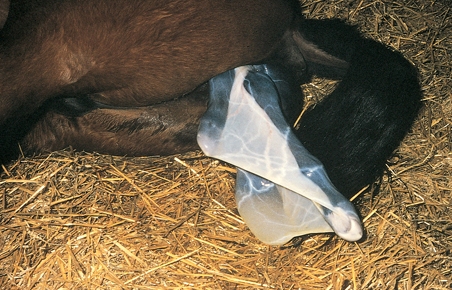Equine Reproduction and Stud Medicine Q&A 17
Jump to navigation
Jump to search

| This question was provided by Manson Publishing as part of the OVAL Project. See more Equine Reproduction and Stud Medicine questions |
One of the three stages of normal spontaneous equine parturition is shown:
| Question | Answer | Article | |
| What stage is this? | Stage 2, during which the actual delivery of the foal takes place. Note the forelimbs enclosed within the bluish-white amnion.
|
[[|Link to Article]] | |
| Under normal undisturbed circumstances, this stage of parturition should not exceed how many minutes? | Thirty minutes; only very rarely will it normally exceed 1 hour. On average, this stage takes some 17 minutes.
|
[[|Link to Article]] | |
| What are the three stages of parturition and what are the principal characteristics of each? | Stage 1: increasing myometrial activity which, together with spontaneous fetal movements, will result in rotation of the cranial part of the fetal body into a dorsosacral position. The front legs and head are extended. Increased uterine activity will also result in dilation of the softened cervix. These processes usually result in discomfort which is demonstrated by restlessness (tail switching, frequently lying down and getting up) and signs of abdominal pain. Patchy sweating (flanks, neck, behind elbows) and yawning/flehmen are other external signs of this stage. Rupture of the allantochorionic membrane and the escape of the allantoic fluid indicates the end of this first stage. This stage may last one to several hours.
Stage 2: obvious, occasionally forceful, abdominal straining marks the beginning of this period during which expulsion of the fetus occurs. As the amnion emerges at the vulva, one foreleg becomes visible, usually preceding the other foreleg by some 10 cm. The foal has a relatively long umbilical cord which is still intact after delivery. The cord usually ruptures at a predetermined place due to movements of the mare and/or foal several minutes (up to 15 minutes) after birth. Stage 3: expulsion of the placenta, which takes approximately 1 hour on average. Continuing myometrial activity plays an important role during this process. |
[[|Link to Article]] | |
